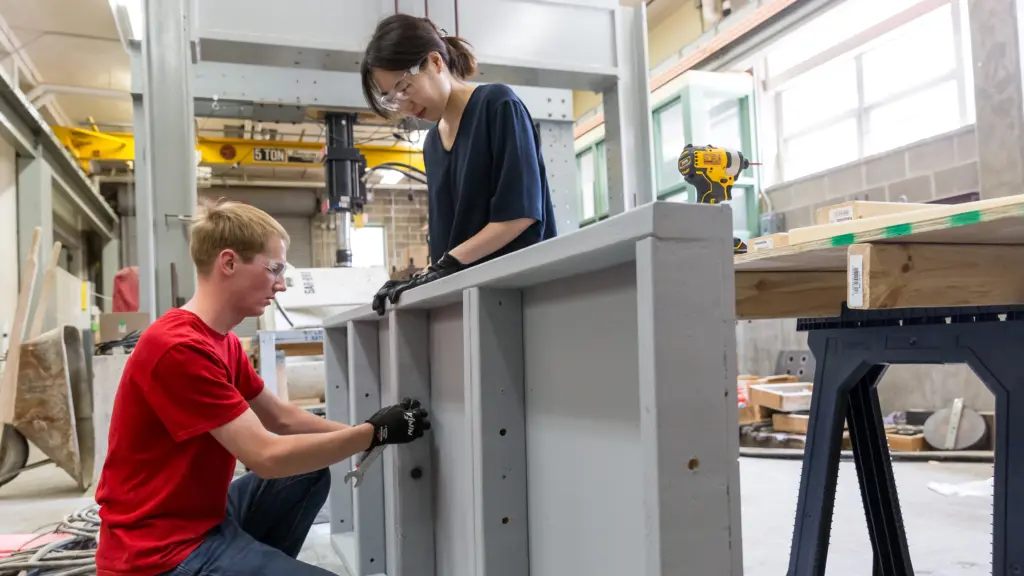A new vacuum box in the Jun and Sandy Lee Wisconsin Structures and Materials Testing Laboratory will allow University of Wisconsin-Madison engineering researchers and students to test how steel deck roofing systems perform under realistic loading conditions.
Civil and Environmental Engineering Assistant Professor Hannah Blum and her students built the box, called the SEAhorse (Suction Experimental Apparatus) through the summer and fall 2023 semesters. The box is 8 feet by 16 feet, stands about 3 feet tall and is bolted to the floor to maintain structural integrity during tests. It’s designed with modular 4-foot sections and can be made larger or smaller, as needed, for future tests. A steel deck can be set across the top, and during tests, vacuums siphon air out of the inside of the box to simulate realistic pressure loads. Valves throughout the box control pressure during tests.
Steel decks are sheets of corrugated metal that are often used as part of roofing structures. “They’re very thin—about 1 to 2 millimeters. In conventional testing, if we want to apply load to test a deck’s capacity, we have to apply load with a spreader beam,” Blum says. “Even with a spreader beam, you’re putting load on concentrated points, and something that thin with a load at a concentrated point might result in a localized failure. That’s not always useful, because in a realistic setting, you’ll have concrete uniformly spread on the deck, which applies load evenly across the deck.”
Vacuum boxes circumvent this conundrum. When air is sucked out of the box, it pulls the deck down, simulating load uniformly across an entire surface. Blum says that approach provides better, more realistic data for how a steel deck might perform in real-world circumstances.
 Undergraduate Lennart-Fredrik Schmitz and postdoctoral associate Hyeyoung Koh build a vacuum box in the June and Sandy Lee Wisconsin Structures and Materials Testing Laboratory. Credit: Alex Holloway.
Undergraduate Lennart-Fredrik Schmitz and postdoctoral associate Hyeyoung Koh build a vacuum box in the June and Sandy Lee Wisconsin Structures and Materials Testing Laboratory. Credit: Alex Holloway.
Thomas Sputo, technical director of the Steel Deck Institute, which is supporting the vacuum box, says it ties into a longer-term initiative involving a number of industry partners to more accurately test and gather data on the reliability of steel systems in buildings.
“Traditionally, we’ve looked at testing from an element-by-element perspective: testing one column, one beam, or one weld,” he says. “The reality is that a building isn’t just a bunch of parts, but a system. So you really need to look at the reliability of all these parts, because combined, it should be better than the reliability of any individual piece.”
To that end, testing with the vacuum box will start with smaller pieces—for example, a steel deck—then ramp up to more complex systems, such as a steel deck with supporting joists that more closely resemble assemblies used in buildings. In those tests, researchers may study scenarios such as how a joist and deck system redistributes load in the event of one part failing.
The new vacuum box benefits undergraduate students because it’s another avenue for them to get hands-on experience and see how the concepts they learn in the classroom can apply to real-world systems.
It can also, Blum says, help students build some of the soft skills that are critical for professional engineers. “Part of it is ethics and responsibility,” Blum says. “If they want to run a test, they have to make sure they’re reporting things accurately. Once they’ve got data, they have to learn how to go through it and use it correctly, and how to write it up in a professional manner. They’re learning teamwork and presentation skills. Some of our newer students might not know what a steel deck is, so on top of all the other things, they’re getting exposed to a different type of structural system and seeing all the possibilities that are out there.”
Blum is the Alain H. Peyrot Fellow in Structural Engineering.
Featured image caption: Postdoctoral associate Hyeyoung Koh, undergraduate Lennart-Fredrik Schmitz and Assistant Professor Hannah Blum with the SEAhorse, a newly constructed vacuum box they’ll use to test the performance of steel deck roofing systems. Photo courtesy of Hannah Blum.